Microscope Condensers
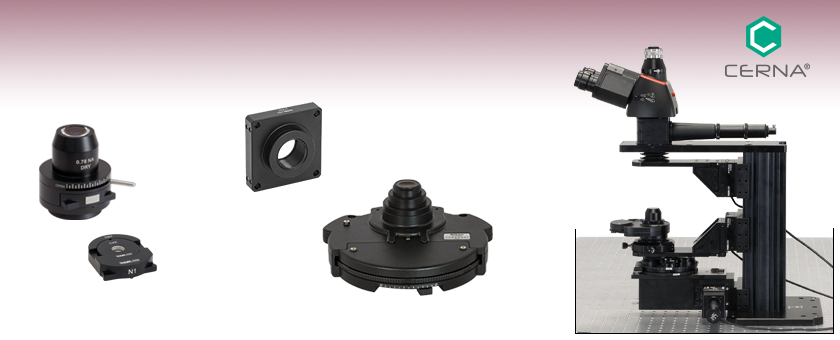
- Microscope Condensers for Visible and NIR Illumination
- Designed for Use with Samples in Air
- High NA of 0.78 or 0.9
CSC2001
Air Condenser,
0.78 NA
CSC1002
Air Condenser, 0.9 NA
Application Idea
The CSC1001 Condenser
Mounted on a Cerna®
Microscope Body
LCPN1
D3N Dovetail Adapter with
60 mm Cage Mounting Holes
C4X Lens Mounted in CN1 Tray Enables Compatibility with 4X Objectives

Please Wait
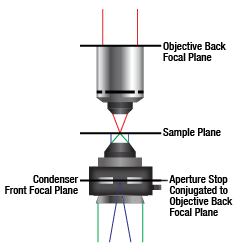
Click to Enlarge
When sending a collimated beam into the condenser the light will be focused onto the sample plane (green ray). In this case the sample plane will be conjugate to the light source, which can lead to forming an image of the light source rather than the sample.
To correct for this, an input beam that is focused (i.e., Köhler Illumination) onto the aperture stop of the condenser can be used (blue ray). In this case, conjugate planes are created at the field stop, condenser aperture stop, and the objective's back focal plane. A collimated beam will then be present at the sample.
| Quick Links |
|---|
| Air Condenser with Exchangeable Tray |
| Air Condensers with Internal Turret |
| Condenser Adapters |
Features
- Aperture Stop for Optimizing Illumination Conditions at the Sample
- Male D3N Dovetail for Mounting in a Condenser Holder or CSA2001 Dovetail Adapter
- Options Available with Slots for DIC Prisms, Illumination Masks, Ø1" Optics, or Ø32 mm Optics
- Adapters to Connect DIY Light Conditioning Setups
- CSA2001: For Mounting Condensers to DIY Setups that Use SM2 Lens Tubes
- LCPN1 and LCPN5: For Attaching Custom-Built Condensers to Cerna or Nikon Microscopes
- Other Nikon Condensers Available Upon Request
To support home-built Cerna® microscope systems, Thorlabs offers four achromatic condensers. Designed for upright microscopes, these condensers collect light emitted by an illumination source to illuminate transmissive samples from beneath the objective. They are used in several transmitted light imaging modalities, including brightfield illumination, Dodt contrast, and differential interference contrast (DIC) imaging, and have an internal turret or tray to mount one or more condenser prisms, illumination masks, and/or other optics.
Aperture Stop Diaphragm
Each condenser is equipped with an adjustable aperture stop diaphragm that is controlled by a lever on the side. For the brightest illumination, the condenser's NA should be equal to or slightly smaller than that of the highest-NA objective that will be used with the microscope. By opening and closing the diaphragm, the effective numerical aperture (NA) of the condenser can be adjusted, allowing it to match the NA of the objective. Note that closing the diaphragm will reduce the illumination intensity.
Condenser Mounting with D3N Dovetail
These condensers can be mounted to a condenser holder using the male D3N dovetail on the bottom. D3N is Thorlabs' designation for the dovetail used by the majority of Nikon condensers for upright microscopes. See the Microscope Dovetails tab for more information.
Condenser Trays and Turrets
Each condenser is equipped with either an internal turret (Item #'s CSC1001 and CSC1002) or a removable tray (Item # CSC2001) to allow for the addition of DIC condenser prisms or other optics. See below for details on the options available for each condenser.
Adapters for DIY Light Conditioning Setups
For custom light conditioning setups, Thorlabs offers the CSA2001, LCPN1, and LCPN5 condenser adapters. The CSA2001 adapter features a female D3N dovetail and external SM2 threads. It can mount condensers with a male D3N dovetail to a DIY optical assembly that uses Thorlabs' SM2 lens tubes. The LCPN1 and LCPN5 adapters feature the same male D3N dovetail as the condensers on this page, allowing a user-constructed condenser to mount onto a condenser holder. The LCPN1 adapter has internal SM30 (M30.5 x 0.5) threading for Ø30 mm lens tubes, and the LCPN5 adapter has internal SM2 (2.035"-40) threading for SM2 lens tubes. Both adapters have cage rod through holes for our 60 mm cage systems. The LCPN1 adapter also has 4-40 tapped holes for our 30 mm cage systems. See the DIY Cerna Interfaces tab for a comprehensive list of dovetail and cage compatibility for the Cerna product line.
| Thorlabs Dovetail Referencea | |||
|---|---|---|---|
| Type | Shape | Outer Dimension | Angle |
| 95 mm | Linear | 95 mm | 45° |
| D1N | Circular | Ø2.018" | 60° |
| D2Nb | Circular | Ø1.50" | 90° |
| D2NBb | Circular | Ø1.50" | 90° |
| D3N | Circular | Ø45 mm | 70° |
| D5N | Circular | Ø1.58" | 90° |
| D6N | Circular | Ø1.90" | 90° |
| D7N | Circular | Ø2.05" | 90° |
| D1T | Circular | Ø1.50" | 60° |
| D3T | Circular | Ø1.65" | 90° |
| D1Y | Circular | Ø107 mm | 60° |
| D2Y | Circular | Ø2.32" | 50° |
| D3Y | Circular | Ø1.75" | 90° |
| D4Y | Circular | Ø56 mm | 60° |
| D5Y | Circular | Ø46 mm | 60° |
| D6Y | Circular | Ø41.9 mm | 45° |
| D1Z | Circular | Ø54 mm | 60° |
| D2Z | Circular | Ø57 mm | 60° |
| D3Z | Circular | Ø54 mm | 45° |
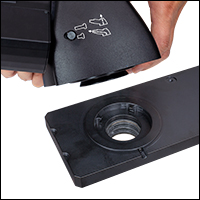
Click to Enlarge
This photo shows the male D1N dovetail on the trinoculars next to the female D1N dovetail on the epi-illumination arm.
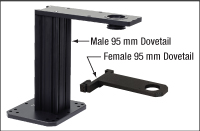
Click to Enlarge
This photo shows the male 95 mm dovetail on the microscope body and the female 95 mm dovetail on the CSA1002 Fixed Arm.
Introduction to Microscope Dovetails
Dovetails are used for mechanical mating and optical port alignment of microscope components. Components are connected by inserting one dovetail into another, then tightening one or more locking setscrews on the female dovetail. Dovetails come in two shapes: linear and circular. Linear dovetails allow the mating components to slide before being locked down, providing flexible positioning options while limiting unneeded degrees of freedom. Circular dovetails align optical ports on different components, maintaining a single optical axis with minimal user intervention.
Thorlabs manufactures many components which use dovetails to mate with our own components or those of other manufacturers. To make it easier to identify dovetail compatibility, we have developed a set of dovetail designations. The naming convention of these designations is used only by Thorlabs and not other microscope manufacturers. The table to the right lists all the dovetails Thorlabs makes, along with their key dimensions.
In the case of Thorlabs’ Cerna® microscopes, different dovetail types are used on different sections of the microscope to ensure that only compatible components can be mated. For example, our WFA2002 Epi-Illuminator Module has a male D1N dovetail that mates with the female D1N dovetail on the microscope body's epi-illumination arm, while the CSS2001 XY Microscopy Stage has a female D1Y dovetail that mates with the male D1Y dovetail on the CSA1051 Mounting Arm.
To learn which dovetail type(s) are on a particular component, consult its mechanical drawing, available by clicking on the red Docs icon (![]() ) below. For adapters with a female dovetail, the drawing also indicates the size of the hex key needed for the locking setscrew(s). It is important to note that mechanical compatibility does not ensure optical compatibility. Information on optical compatibility is available from Thorlabs' web presentations.
) below. For adapters with a female dovetail, the drawing also indicates the size of the hex key needed for the locking setscrew(s). It is important to note that mechanical compatibility does not ensure optical compatibility. Information on optical compatibility is available from Thorlabs' web presentations.
For customers interested in machining their own dovetails, the table to the right gives the outer diameter and angle (as defined by the drawings below) of each Thorlabs dovetail designation. However, the dovetail's height must be determined by the user, and for circular dovetails, the user must also determine the inner diameter and bore diameter. These quantities can vary for dovetails of the same type. One can use the intended mating part to verify compatibility.
In order to reduce wear and simplify connections, dovetails are often machined with chamfers, recesses, and other mechanical features. Some examples of these variations are shown by the drawings below.

Click to Enlarge
Two examples of how circular male dovetails can be manufactured.

Click to Enlarge
Two examples of how circular female dovetails can be manufactured.
Standard Mechanical Interfaces on DIY Cerna® Components
The table below gives the dovetail, optical component threads, and cage system interfaces that are present on each DIY Cerna component. If a DIY Cerna component does not have one of the standard interfaces in the table, it is not listed here. Please note that mechanical compatibility does not ensure optical compatibility. Information on optical compatibility is available from Thorlabs' web presentations.
| Item # | Microscope Dovetails | Optical Component Threadsa | Cage Systemsb | ||||||||||
|---|---|---|---|---|---|---|---|---|---|---|---|---|---|
| 95 mm | D1N | D2N | D2NB | D3N | D5N | D1T | D3T | D1Y | D5Y | Internal | External | ||
| 2CM1 | - | - | - | - | - | - | - | - | - | - | SM1c (1.035"-40) and SM2d (2.035"-40) | SM1c (1.035"-40) | 60 mmd |
| 2CM2 | - | - | - | - | - | - | - | - | - | - | SM1c (1.035"-40) and SM2d (2.035"-40) | SM1c (1.035"-40) | 30 mmc |
| BSA2000e | - | - | - | - | Female | - | - | - | - | - | - | - | - |
| CEA1350 | Male | Female | - | - | - | - | - | - | - | - | - | - | 60 mmd |
| CEA1400 | Male | Female | - | - | - | - | - | - | - | - | - | - | 60 mmd |
| CEA1500 | Male | Female | - | - | - | - | - | - | - | - | - | - | 60 mmd |
| CEA1600 | Male | Female | - | - | - | - | - | - | - | - | - | - | 60 mmd |
| CFB1500 | Male | - | - | - | - | - | - | - | - | - | - | - | - |
| CSA1000 | Female | - | - | - | - | - | - | - | - | - | - | - | - |
| CSA1001 | Female | - | - | - | - | - | - | - | - | - | SM1c (1.035"-40) | - | 30 mmc |
| CSA1002 | Female | - | - | - | - | - | - | - | - | - | SM2d (2.035"-40) | - | 60 mmd |
| CSA1003 | - | Female | - | - | - | - | - | - | - | - | - | - | 60 mmd |
| CSA1051 | Female | - | - | - | - | - | - | - | Male | - | - | - | - |
| CSA1200e,f | - | - | - | - | - | - | - | - | - | - | - | - | 60 mmd |
| CSA1400e | - | - | - | - | - | - | Female | - | - | - | - | - | 60 mmd |
| CSA1500e,g | - | - | - | - | - | - | - | - | - | - | - | - | - |
| CSA2000e | - | - | - | - | Female | - | - | - | - | - | SM2d (2.035"-40) | - | 60 mmd |
| CSA2001 | - | - | - | - | Female | - | - | - | - | - | - | SM2d (2.035"-40) | - |
| CSA2100e | - | - | - | - | - | - | - | - | - | - | SM2d (2.035"-40) | - | 60 mmd |
| CSA3000(/M) | - | Male | - | - | - | - | - | - | - | - | - | - | - |
| CSA3010(/M) | - | Male | - | - | - | - | - | - | - | - | - | - | 30 mmc and 60 mmd |
| Item # | 95 mm | D1N | D2N | D2NB | D3N | D5N | D1T | D3T | D1Y | D5Y | Internal | External | Cage Systems |
| CSC1001 | - | - | - | - | Male | - | - | - | - | - | - | - | - |
| CSC1002 | - | - | - | - | Male | - | - | - | - | - | - | - | - |
| CSC2001 | - | - | - | - | Male | - | - | - | - | - | - | - | - |
| CSD1001 | - | Male & Female | - | Female | - | - | - | - | - | - | - | - | - |
| CSD1002 | - | Male & Female | - | - | - | - | - | - | - | - | - | C-Mounth | - |
| CSE2000 | - | Male & Female | - | - | - | - | - | - | - | - | - | - | 60 mmd |
| CSE2100 | - | Male & Female | - | - | - | - | - | Female | - | - | SM1c (1.035"-40) | - | 30 mmc and 60 mmd |
| CSE2200 | - | Male & Female | - | - | - | - | - | Female | - | - | SM1c (1.035"-40) | - | 30 mmc and 60 mmd |
| CSN100e | - | - | - | - | - | - | - | - | - | - | M32 x 0.75 | - | 60 mmd |
| CSN110 | - | - | - | - | - | - | Male | - | - | - | M32 x 0.75 | - | 30 mmc and 60 mmd |
| CSNK10 | - | - | - | - | - | - | - | - | - | - | M32 x 0.75 | - | 60 mmd |
| CSNK100e | - | - | - | - | - | - | - | - | - | - | M32 x 0.75 | - | 60 mmd |
| CSN200 | - | - | - | - | - | - | Male | - | - | - | M32 x 0.75 | - | - |
| CSN210 | - | - | - | - | - | - | Male | - | - | - | M32 x 0.75 | - | - |
| CSN1201f | - | - | - | - | - | - | - | - | - | - | M32 x 0.75 | - | - |
| CSN1202f | - | - | - | - | - | - | - | - | - | - | M25 x 0.75 | - | - |
| CSS2001 | - | - | - | - | - | - | - | - | Female | - | - | - | - |
| LAURE1 | - | Male | Female | - | - | - | - | - | - | - | - | - | - |
| LAURE2 | - | Male | Female | - | - | - | - | - | - | - | - | - | - |
| LCPN1 | - | - | - | - | Male | - | - | - | - | - | SM30 (M30.5 x 0.5) | - | 30 mmc and 60 mmd |
| LCPN2 | - | Male | - | - | - | - | - | - | - | - | SM30 (M30.5 x 0.5) | - | 30 mmc and 60 mmd |
| Item # | 95 mm | D1N | D2N | D2NB | D3N | D5N | D1T | D3T | D1Y | D5Y | Internal | External | Cage Systems |
| LCPN3 | - | Male | - | - | - | - | - | - | - | Female | SM30 (M30.5 x 0.5) | - | 60 mmd |
| LCPN4 | - | Male | - | - | - | - | - | - | - | - | SM2d (2.035"-40) | - | 60 mmd |
| LCPN5 | - | - | - | - | Male | - | - | - | - | - | SM2d (2.035"-40) | - | 60 mmd |
| LCPN6 | - | - | Female | - | - | - | - | - | - | - | SM1c (1.035"-40) | - | 30 mmc and 60 mmd |
| LCPY2 | - | - | - | - | - | - | - | - | - | Male | SM30 (M30.5 x 0.5) | - | 30 mmc and 60 mmd |
| LCPY3 | - | - | - | - | - | - | - | - | - | Female | - | - | 30 mmc and 60 mmd |
| OPX2400(/M) | - | Male & Female | - | - | - | - | - | - | - | - | SM2d (2.035"-40) | - | 60 mmd |
| SM1A70 | - | - | - | - | - | - | - | - | - | - | SM30 (M30.5 x 0.5) | SM1c (1.035"-40) | - |
| SM1A58 | - | - | Male | Male | - | - | - | - | - | - | SM1c (1.035"-40) | SM2d (2.035"-40) | 30 mmc |
| SM2A56 | - | - | - | - | - | - | - | Male | - | - | - | SM2d (2.035"-40) | - |
| SM2A59 | - | Male | - | - | - | - | - | - | - | - | SM2d (2.035"-40) | - | - |
| TC1X | - | - | Male | - | - | - | - | - | - | - | - | - | - |
| WFA0150 | Female | - | - | - | - | - | - | - | - | - | - | - | - |
| WFA1000 | - | - | - | - | - | - | - | - | - | - | - | - | 30 mmc |
| WFA1010 | - | - | - | - | - | - | - | - | - | - | SM1c (1.035"-40) | - | 30 mmc |
| WFA1020 | - | - | - | - | - | - | - | - | - | - | SM1c (1.035"-40) | - | 30 mmc |
| WFA1051 | - | - | - | - | - | - | - | - | - | - | SM1c (1.035"-40) | - | 30 mmc |
| WFA1100 | - | - | - | - | - | - | - | - | - | - | - | - | 30 mmc |
| WFA2001 | - | Male & Female | - | - | - | - | - | - | - | - | SM1c (1.035"-40) | SM1c (1.035"-40) | - |
| WFA2002 | - | Male & Female | - | - | - | - | - | - | - | - | SM1c (1.035"-40) | - | 30 mmc |
| Item # | 95 mm | D1N | D2N | D2NB | D3N | D5N | D1T | D3T | D1Y | D5Y | Internal | External | Cage Systems |
| WFA4100 | - | Male | - | - | - | - | - | - | - | - | SM1c (1.035"-40) | C-Mounth | - |
| WFA4101 | - | Male | - | - | - | - | - | - | - | - | SM1c (1.035"-40) | C-Mounth | - |
| WFA4102 | - | Male | - | - | - | - | - | - | - | - | SM1c (1.035"-40) | C-Mounth | - |
| WFA4111 | - | Male | - | - | - | - | - | - | - | - | - | SM2d (2.035"-40) | - |
| WFA4112 | - | - | - | Male | - | - | - | - | - | - | - | C-Mounth | - |
| Female | - | - | - | - | - | - | - | - | - | - | - | - | |
| Female | - | - | - | - | - | - | - | - | - | - | - | - | |
| Female | - | - | - | - | - | - | - | - | - | - | - | - | |
| Female | - | - | - | - | - | - | - | - | - | - | - | - | |
| XT95P12(/M) | Female | - | - | - | - | - | - | - | - | - | - | - | - |
| ZFM1020 | Female | - | - | - | - | - | - | - | - | - | - | - | - |
| ZFM1030 | Female | - | - | - | - | - | - | - | - | - | - | - | - |
| ZFM2020 | Female | - | - | - | - | - | - | - | - | - | - | - | - |
| ZFM2030 | Female | - | - | - | - | - | - | - | - | - | - | - | - |
Building a Cerna® Microscope
The Cerna microscopy platform's large working volume and system of dovetails make it straightforward to connect and position the components of the microscope. This flexibility enables simple and stable set up of a preconfigured microscope, and provides easy paths for later upgrades and modification. See below for a couple examples of the assembly of some DIY Cerna microscopes.
DIY Cerna Design and Assembly
Walkthrough of a DIY Microscope Configuration
This DIY microscope uses a CSA3000(/M) Breadboard Top, a CSA2001 Dovetail Adapter, our CSA1001 and CSA1002 Fixed Arms, and other body attachments and extensions. These components provide interfaces to our lens tube and cage construction systems, allowing the rig to incorporate two independent trans-illumination modules, a home-built epi-illumination path, and a custom sample viewing optical path.
The simplicity of Thorlabs optomechanical interfaces allows a custom DIY microscope to be quickly assembled and reconfigured for custom imaging applications.
The Condenser Lens and Köhler Illumination in Microscopy Systems
The resolution of microscopy images is affected by several factors, including the numerical aperture (NA) of the condenser lens and the uniformity of the sample plane illumination. The NA of the condenser lens should be at least as large as the NA of the objective lens. Under these conditions, the condenser lens illuminates the sample over a range of angles that is at least as wide as the range of angles over which the objective lens collects light from the sample. In order to provide uniform illumination of the sample plane, a technique called Köhler illumination is often used. An important result of this illumination approach is that the source and sample are never imaged to the same plane. The following include more information about the relationship between the condenser and objective lenses, as well as Köhler illumination:
- Does the condenser's NA affect the microscope's resolution?
- How does Köhler illumination work in microscopy?
Click here for more Insights about lab practices and equipment.
Does the condenser's NA affect the microscope's resolution?
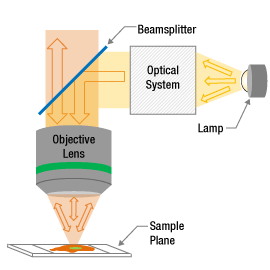
Click to Enlarge
Figure 2: In epi-illumination microscopes, the objective provides the light that illuminates the sample. It also collects the light reflected and scattered from the sample. Due to this, and in contrast to the case illustrated in Figure 1, both the illumination and imaging angles depend only on the objective.
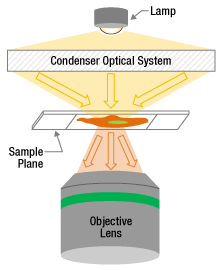
Click to Enlarge
Figure 1: In transmitted light microscopes, light from the light source is directed to the sample by the condenser optical system. The objective lens is used to collect the transmitted light. This collected light is then routed to create an image at a camera or eyepiece.
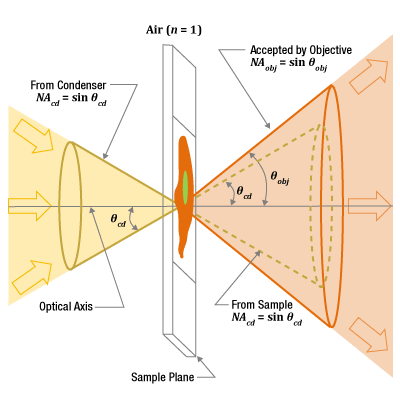
Click to Enlarge
Figure 3: Cones describe the light incident on a sample point from the condenser (left, gold), the light transmitted through the sample (right, yellow), and the range of light the objective can collect (right, orange). The cones' angles are measured from the optical axis. The angular ranges of the light cones incident on and transmitted by the sample are approximately the same
The condenser's numerical aperture (NA) strongly impacts a microscope's resolution, since the angular range of the light incident on the sample affects the angular range of light transmitted or reflected by the sample. According to a general rule for optimizing resolution, the condenser NA should be as least as large as the objective NA. In other words, the cone of light provided by the condenser should have an angular range that matches or exceeds that accepted by the objective lens.
Condenser and Objective
In transmitted light microscopy, the condenser collects light from the source and illuminates the sample (Figure 1). The condenser optica system typically includes several optical elements, which can be aligned to provide uniform illumination of the sample plane. The objective lens is located on the opposite side of the sample plane and collects the light that is transmitted through the sample. This light is then routed to create an image at an eyepiece or camera.
Alternately, the microscope can be configured so the objective both illuminates and collects light from the sample (Figure 2). In this case, there is no separate condenser lens system.
Numerical Aperture
The condenser provides light to the sample plane over a range of different angles (Figure 3). A cone, drawn with its tip at a point on the sample and its base encircling the light from the condenser, can be used to quantify the range of incident angles
These angular ranges can be quantified by each lens' numerical aperture (NA),
NA = n sin(θ ),
which depends on the half-angle (θ ) of the cone, as well as the surrounding medium's refractive index (n ). The higher the NA, the wider the cone describing the angular range. This angle is measured from the optical axis.
As an example, when the objective lens has a 0.7 NA with air
Resolution
The resolution (δ ) of the microscope describes its ability to image two closely spaced points as a separable pair, instead of as a single point. A common equation,

used to estimate this minimum separation includes only the wavelength 
When

provides a better estimate and illustrates the importance of the condenser's NA to the resolution.
How does Köhler illumination work in microscopy?
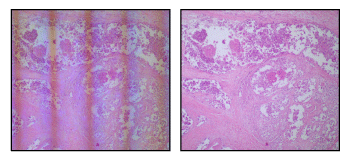
Click to Enlarge
Figure 4: An image of the source includes the structure of the light emitting elements (left). Köhler illumination avoids imaging the source to the sample or sensor planes and provides uniform illumination to the sample plane (right).
A multi-element microscopy system can be aligned to provide Köhler (Koehler) illumination, in which the light collected from a light source like a lamp or light emitting diode (LED) is imaged differently than the light collected from the sample. The light source is intentionally never imaged to the sample (object) plane or to the camera sensor. The sample plane is instead uniformly illuminated, typically over the broad range of angles required for high-resolution imaging. As a result, Köhler illumination prevents superimposing an image of the lamp or LED structure onto the camera sensor.
Image of the Light Source
An image of the light source at the sample plane would not uniformly illuminate the sample (Figure 4, left, for example), since the light-emitting structures are clearly visible in images of the source. Köhler illumination instead uniformly illuminates the sample plane (Figure 4, right) by providing the light to the sample plane as bundles of parallel rays. In addition, aligning the system to provide Köhler illumination prevents the light source from being imaged at the camera sensor, which would superimpose an image of the light-emitting structures onto the image of the sample.
Illumination Light Path
The illumination path begins with the light source and passes through the sample to the camera sensor. The video animation (Video 1, below) traces rays from an extended source, like a lamp or LED, through this light path.
Each of the multiple light-emitting points on the source radiate light over a range of angles. The collector lens gathers this light and transmits a beam whose maximum diameter is limited by the field stop. The light is then incident on the field lens, which forms an image of each source point at the aperture stop. The alignment of the source image at the aperture stop is critical, since the aperture stop is positioned at the front focal plane of the condenser lens.
The image of the source at the aperture stop provides light to the condenser lens, which transmits the light as bundles of parallel rays. Each bundle of rays originates from a unique point on the source image. The angle at which a particular bundle of rays is incident on the sample plane is larger when the source point is displaced farther from the optical axis. In other words, closing the aperture stop would reduce the range of illumination angles, as well as the illumination intensity at the sample plane.
Since an image of the source is at the front focal plane of the condenser lens, only bundles of parallel rays are incident on the sample plane. No source image is formed at the sample and the illumination is uniform.
Source light transmitted through the sample plane is imaged to the objective back focal plane, which is located between the objective and tube lenses. No image of the light source is formed on the camera sensor, which preserves image quality.
Imaging Light Path
The imaging path begins at the sample plane and ends at the camera sensor, and the video animation also traces rays through this light path. Each point on the sample is imaged to a point on the camera sensor.
Video 1: Optical elements in a transmission microscope, labeled on the left, are shown after they have been aligned to provide Köhler illumination. Under these conditions, as illustrated by the light rays traced through the illumination path in the animation, the sample plane is uniformly illuminated and images of the light source are not superimposed on the sample or camera sensor. In contrast, the light rays traced through the imaging path illustrate that the same optics do image the sample plane onto the camera sensor.
Click on the different parts of the microscope to explore their functions.
Elements of a Microscope
This overview was developed to provide a general understanding of a Cerna® microscope. Click on the different portions of the microscope graphic to the right or use the links below to learn how a Cerna microscope visualizes a sample.
Terminology
Arm: Holds components in the optical path of the microscope.
Bayonet Mount: A form of mechanical attachment with tabs on the male end that fit into L-shaped slots on the female end.
Bellows: A tube with accordion-shaped rubber sides for a flexible, light-tight extension between the microscope body and the objective.
Breadboard: A flat structure with regularly spaced tapped holes for DIY construction.
Dovetail: A form of mechanical attachment for many microscopy components. A linear dovetail allows flexible positioning along one dimension before being locked down, while a circular dovetail secures the component in one position. See the Microscope Dovetails tab or here for details.
Epi-Illumination: Illumination on the same side of the sample as the viewing apparatus. Epi-fluorescence, reflected light, and confocal microscopy are some examples of imaging modalities that utilize epi-illumination.
Filter Cube: A cube that holds filters and other optical elements at the correct orientations for microscopy. For example, filter cubes are essential for fluorescence microscopy and reflected light microscopy.
Köhler Illumination: A method of illumination that utilizes various optical elements to defocus and flatten the intensity of light across the field of view in the sample plane. A condenser and light collimator are necessary for this technique.
Nosepiece: A type of arm used to hold the microscope objective in the optical path of the microscope.
Optical Path: The path light follows through the microscope.
Rail Height: The height of the support rail of the microscope body.
Throat Depth: The distance from the vertical portion of the optical path to the edge of the support rail of the microscope body. The size of the throat depth, along with the working height, determine the working space available for microscopy.
Trans-Illumination: Illumination on the opposite side of the sample as the viewing apparatus. Brightfield, differential interference contrast (DIC), Dodt gradient contrast, and darkfield microscopy are some examples of imaging modalities that utilize trans-illumination.
Working Height: The height of the support rail of the microscope body plus the height of the base. The size of the working height, along with the throat depth, determine the working space available for microscopy.
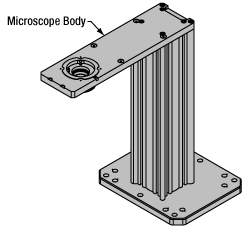 Click to Enlarge
Click to EnlargeCerna Microscope Body
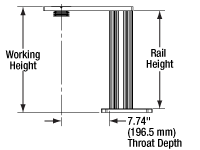
Click to Enlarge
Body Details
Microscope Body
The microscope body provides the foundation of any Cerna microscope. The support rail utilizes 95 mm rails machined to a high angular tolerance to ensure an aligned optical path and perpendicularity with the optical table. The support rail height chosen (350 - 600 mm) determines the vertical range available for experiments and microscopy components. The 7.74" throat depth, or distance from the optical path to the support rail, provides a large working space for experiments. Components attach to the body by way of either a linear dovetail on the support rail, or a circular dovetail on the epi-illumination arm (on certain models). Please see the Microscope Dovetails tab or here for further details.
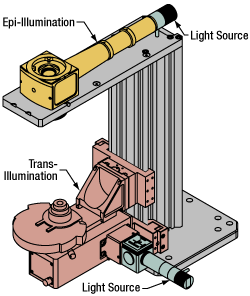 Click to Enlarge
Click to EnlargeIllumination with a Cerna microscope can come from above (yellow) or below (orange). Illumination sources (green) attach to either.
Illumination
Using the Cerna microscope body, a sample can be illuminated in two directions: from above (epi-illumination, see yellow components to the right) or from below (trans-illumination, see orange components to the right).
Epi-illumination illuminates on the same side of the sample as the viewing apparatus; therefore, the light from the illumination source (green) and the light from the sample plane share a portion of the optical path. It is used in fluorescence, confocal, and reflected light microscopy. Epi-illumination modules, which direct and condition light along the optical path, are attached to the epi-illumination arm of the microscope body via a circular D1N dovetail (see the Microscope Dovetails tab or here for details). Multiple epi-illumination modules are available, as well as breadboard tops, which have regularly spaced tapped holes for custom designs.
Trans-illumination illuminates from the opposite side of the sample as the viewing apparatus. Example imaging modalities include brightfield, differential interference contrast (DIC), Dodt gradient contrast, oblique, and darkfield microscopy. Trans-illumination modules, which condition light (on certain models) and direct it along the optical path, are attached to the support rail of the microscope body via a linear dovetail (see Microscope Dovetails tab or here). Please note that certain imaging modalities will require additional optics to alter the properties of the beam; these optics may be easily incorporated in the optical path via lens tubes and cage systems. In addition, Thorlabs offers condensers, which reshape input collimated light to help create optimal Köhler illumination. These attach to a mounting arm, which holds the condenser at the throat depth, or the distance from the optical path to the support rail. The arm attaches to a focusing module, used for aligning the condenser with respect to the sample and trans-illumination module.
 |
 |
 |
 |
 |
 |
 |
 |
| Epi-Illumination Modules | Breadboards & Body Attachments |
Brightfield | DIC | Dodt | Condensers | Condenser Mounting | Light Sources |
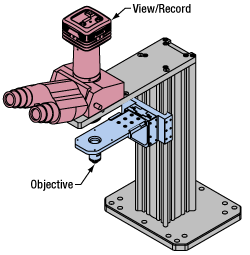 Click to Enlarge
Click to EnlargeLight from the sample plane is collected through an objective (blue) and viewed using trinocs or other optical ports (pink).
Sample Viewing/Recording
Once illuminated, examining a sample with a microscope requires both focusing on the sample plane (see blue components to the right) and visualizing the resulting image (see pink components).
A microscope objective collects and magnifies light from the sample plane for imaging. On the Cerna microscope, the objective is threaded onto a nosepiece, which holds the objective at the throat depth, or the distance from the optical path to the support rail of the microscope body. This nosepiece is secured to a motorized focusing module, used for focusing the objective as well as for moving it out of the way for sample handling. To ensure a light-tight path from the objective, the microscope body comes with a bellows (not pictured).
Various modules are available for sample viewing and data collection. Trinoculars have three points of vision to view the sample directly as well as with a camera. Double camera ports redirect or split the optical path among two viewing channels. Camera tubes increase or decrease the image magnification. For data collection, Thorlabs offers both cameras and photomultiplier tubes (PMTs), the latter being necessary to detect fluorescence signals for confocal microscopy. Breadboard tops provide functionality for custom-designed data collection setups. Modules are attached to the microscope body via a circular dovetail (see the Microscope Dovetails tab or here for details).
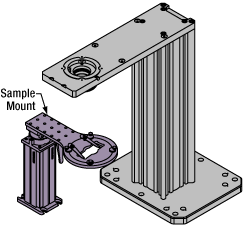 Click to Enlarge
Click to EnlargeThe rigid stand (purple) pictured is one of various sample mounting options available.
Sample/Experiment Mounting
Various sample and equipment mounting options are available to take advantage of the large working space of this microscope system. Large samples and ancillary equipment can be mounted via mounting platforms, which fit around the microscope body and utilize a breadboard design with regularly spaced tapped through holes. Small samples can be mounted on rigid stands (for example, see the purple component to the right), which have holders for different methods of sample preparation and data collection, such as slides, well plates, and petri dishes. For more traditional sample mounting, slides can also be mounted directly onto the microscope body via a manual XY stage. The rigid stands can translate by way of motorized stages (sold separately), while the mounting platforms contain built-in mechanics for motorized or manual translation. Rigid stands can also be mounted on top of the mounting platforms for independent and synchronized movement of multiple instruments, if you are interested in performing experiments simultaneously during microscopy.
| Posted Comments: | |
Espen Hartveit
(posted 2023-03-07 16:09:01.597) 1) It would be nice if you could explain why this product has been discontinued, given that there does not seem to be a replacement?
2) It would be nice if in addition to the CAD documentation etc., you could provide a manual / documentation that focuses on the optical / imaging aspects of this condenser
Thanks,
Espen Hartveit jgreschler
(posted 2023-03-27 10:11:05.0) Thank you for reaching out to Thorlabs. In this case since CSC1003 was a vendor supplied part from Nikon our role in obsolescence and replacement is limited. I have reached out to you directly to discuss possible alternatives. Ozan ARI
(posted 2019-04-30 06:18:55.897) Greetings,
We would like to build a home-made transmission mapping microscopy setup. We have almost determined all the parts we need but condenser. We want to perform trans. measurements in NIR (700-1100 nm), MIR (3-5 um), and LWIR (8-14 um) with thorlabs reflective objectives (15x, 25x with 0.3 and 0.4 NA). However we could not find any condenser to work on these specific regions. Could you suggest us any of these? What is the transmission range of the CSC2001 beyond 2500 nm as given in specs? If there is no specific condenser in this list for IR and beyond should we switch a custom design with achromatic lenses for required coatings as ZnSe?
Regards YLohia
(posted 2019-04-30 04:46:17.0) Hello, thank you for contacting Thorlabs. Unfortunately, we don't have transmission data for condensers other than the CSC2001 since those are made by Nikon (as of 4/2019). I am reaching out to you directly with the extended range data for the CSC2001 as well as to discuss the possibility of a customized condenser. chunghalee
(posted 2019-02-18 06:56:44.607) Hello, this is Chungha Lee from a biomedical optics laboratory in South Korea.
I have a question about your product, oil immersion condensor CSC1003.
What is the "magnification" of this condenser lens, calculated from tube lens with what(how long) "focal length".
I figured out that the standard focal length of Nikon microscope is 200 mm, but I want to check it.
Thanks,
Chungha Lee YLohia
(posted 2019-02-19 08:28:50.0) Hello Chungha, thank you for contacting Thorlabs. Microscope condenser lenses such as the CSC1003 are intended to be used for the collection of light as opposed to imaging the sample. Therefore, we do not specify any magnification for these. I will reach out to you directly to find out more about your application. |

| Item # | CSC2001 |
|---|---|
| Photo (Click to Enlarge) |
 |
| Condenser Type | Achromatic |
| Numerical Aperture (NA) | 0.78 |
| Aperture Adjustment | Yes |
| Wavelength Range | 400 - 850 nm |
| AR Coating | Ravg < 2% for 400 - 850 nm |
| Transmission Plot | Click for Raw Data |
| Axial Color | <25 μm over 450 - 700 nm |
| Working Distance | 6.6 mm |
| Recommended Objective Magnification |
10X - 100X (4X with C4X Lens) |
| Dovetail | Male D3N |
| Internal Traya | |
| Tray Slots | 1 |
| Clear Apertureb | Ø30.0 mm (Ø1.18") |
| DIC Prism | Via CN1 and CN2 Traysc |
| Oblique | No |
| Darkfield | No |
| Phase | No |
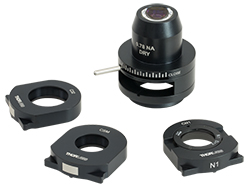
Click to Enlarge
View Product List
One C32 Tray is Included with the Condenser and Additional Trays can be Purchased to Accommodate Various Optics
- Designed for Use with Samples in Air
- Achromatic Design Corrects for Chromatic Aberrations
- Exchangeable Trays for Mounting a DIC Prism, a Lens for Compatibility with 4X Objectives, a Ø1" Optic, or a Ø32 mm Optic
- Bottom-Located Male D3N Dovetail for Mounting on Condenser Holders or CSA2001 Dovetail Adapter
This achromatic air condenser is designed to be used with dry objectives. It is equipped with an adjustable aperture stop diaphragm that is controlled by a lever on the side, as shown in the drawing below.
The CSC2001 contains an internal slot that accommodates trays designed to mount various optics. Magnets in the tray and inside the slot ensure easy exchange and repeatable positioning of optics within the condenser. The CSC2001 condenser comes with one C32 tray for mounting Ø32 mm optics. Additionally, we offer the CN1 and CN2 trays for use with DIC condenser prisms and the CSM tray for mounting Ø1" optics. For tray specifications see the table below.
The CSC2001 works out-of-the-box with objectives ranging from 10X to 100X by adjusting the cone of illumination with the aperture diaphragm. For compatibility with 4X objective lenses, we offer the C4X lens, which is easily positioned within the CSC2001 using a CN1 tray (all items sold separately). For C4X specifications see the table below.
| Compatible Trays | ||||
|---|---|---|---|---|
| Item # | CN1 | CN2 | CSM | C32 |
| Photo (Click to Enlarge) |
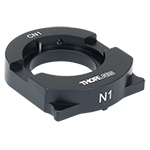 |
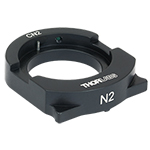 |
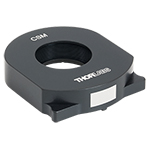 |
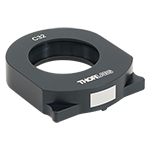 |
| Compatible Optics | WFA3130 N1 DIC Condenser Prism or C4X Lens | WFA3131 N2 DIC Condenser Prism | Ø1" Optics up to 0.35" (8.9 mm) Thicka | Ø32 mm Optics up to 0.35" (8.9 mm) Thicka |
| Optic Securing | M3 Setscrew with 1.5 mm Hex | M3 Setscrew with 1.5 mm Hex | One SM1RR Retaining Ring | Two SM32RR Retaining Rings |
| Lens for 4X Objectives (Item # C4X) | ||||||
|---|---|---|---|---|---|---|
| Photo (Click to Enlarge) |
Wavelength Range | AR Coating | Transmission Plot | Clear Aperture | Surface Quality | Mounting Options |
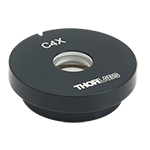 |
400 - 850 nm | Ravg < 2% for 400 - 850 nm | Click for Raw Data |
Ø10.0 mm | 80-50 Scratch-Dig |
Compatible with CN1 Tray |
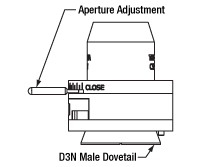
Click to Enlarge
Condenser Schematic

- Designed for Use with Samples in Air
- Design Corrects for Chromatic Aberrations
- Internal Turret with Slots for Mounting DIC Condenser Prisms and Illumination Masks
- Bottom-Located Male D3N Dovetail for Mounting on Condenser Holders or CSA2001 Dovetail Adapter
These achromatic air condensers are designed to be used with dry objectives. They are equipped with an adjustable aperture stop diaphragm that is controlled by a lever on the side, as shown in the below drawing.
The CSC1001 and CSC1002 each contain an internal turret with four or seven slots, respectively, that is designed to mount DIC condenser prisms and illumination masks. This feature makes these condensers ideal for use in brightfield and oblique illumination, Dodt contrast, and DIC imaging. Please see the table to the left for the slots available in each turret. Each slot can be rotated into the beam path using a knurled dial on the side of the condenser. Labels are included that can be attached to the dial to indicate which slot is currently in the optical path. As shown in the photo below, the turret's slots can be accessed by removing the top cover using a 5/64" (2 mm) hex key.
For DIC imaging, Thorlabs offers N1 and N2 dry condenser prisms as well as N1 and N2 dry objectives. Note that an objective will have an N1 or N2 engraving to denote compatibility with a condenser prism.
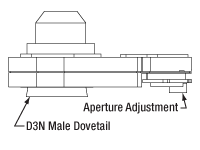
Click to Enlarge
Condenser Schematic

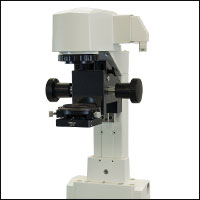
Click to Enlarge
LCPN1 Adapter Attached to Inverted Nikon Eclipse Condenser Holder
- Extends Versatility of Thorlabs' Lens Tube and Cage Construction Systems to DIY Cerna® Systems
- CSA2001: Female D3N Dovetail and External SM2 Threads
- LCPN1: Male D3N Dovetail, Internal SM30 Threads, and 30 mm and 60 mm Cage Compatible
- LCPN5: Male D3N Dovetail, Internal SM2 Threads, and 60 mm Cage Compatible
These condenser adapters allow DIY light conditioning setups to be integrated into a Cerna microscope.
The CSA2001 adapter is used to mount a condenser with a male D3N dovetail to an optical assembly that uses Thorlabs' SM2 lens tubes. A 2 mm hex setscrew is included to secure the dovetail of the adapter to the condenser.
The LCPN1 and LCPN5 adapters allow the user to attach a custom-built condenser or other light conditioning module to a Cerna, inverted Nikon Eclipse Ti, or upright Nikon Eclipse microscope. The adapters utilize the same male D3N dovetail as the above condensers; see the Microscope Dovetails tab for details. The LCPN1 adapter features internal SM30 (M30.5 x 0.5) threading for Ø30 mm lens tubes; two SM30RR retaining rings are included to secure an optic inside the adapter. The LCPN5 adapter features SM2 (2.035"-40) threading for SM2 lens tubes and includes one SM2RR retaining ring. Both adapters have four through holes with side-located locking setscrews (5/64" [2 mm] hex) that can be used to attach Ø6 mm cage rods for 60 mm cage systems. Additionally, the LCPN1 adapter features 4-40 tapped holes on 30 mm centers, located on the side opposite the dovetail, which can be used for 30 mm cage systems.
Note: Thorlabs does not guarantee compatibility with other industry-standard microscopes not explicitly mentioned on this webpage.
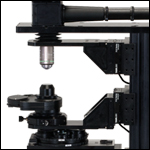
Click to Enlarge
Our CSA2001 adapter has a female D3N dovetail that mates to the male D3N dovetail on a condenser. Here, the external SM2 threads on the adapter are threaded into our CXY2A mount.
 Products Home
Products Home















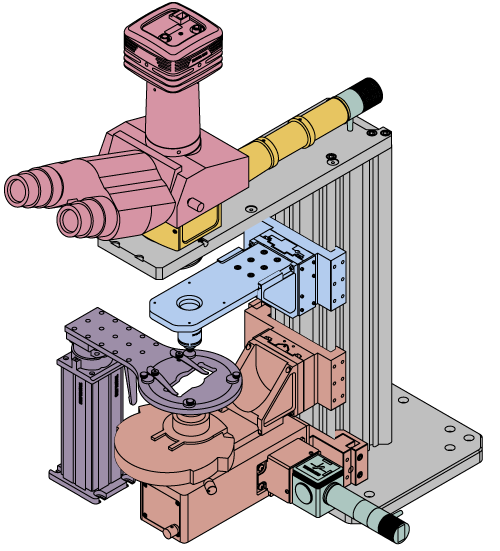























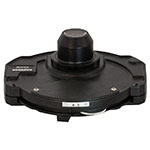
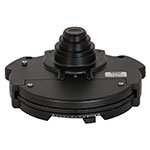




 Condensers
Condensers